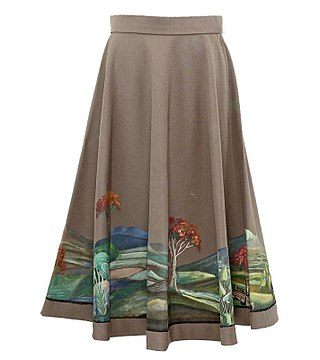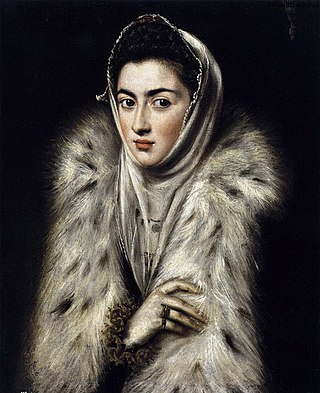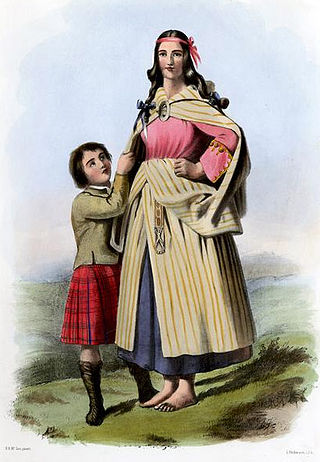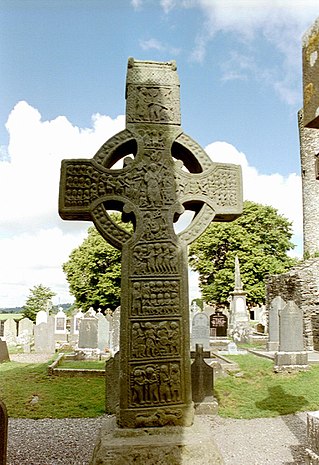
A kilt is a garment resembling a wrap-around knee-length skirt, made of twill-woven worsted wool with heavy pleats at the sides and back and traditionally a tartan pattern. Originating in the Scottish Highland dress for men, it is first recorded in the 16th century as the great kilt, a full-length garment whose upper half could be worn as a cloak. The small kilt or modern kilt emerged in the 18th century, and is essentially the bottom half of the great kilt. Since the 19th century, it has become associated with the wider culture of Scotland, and more broadly with Gaelic or Celtic heritage.

A draped garment is a garment that is made of a single piece of cloth that is draped around the body; drapes are not cut away or stitched as in a tailored garment. Drapes can be held to the body by means of knotting, pinning, fibulae, clasps, sashes, belts, tying drawstrings, or just plain friction and gravity alone. Many draped garments consist of only one single piece.

A skirt is the lower part of a dress or a separate outer garment that covers a person from the waist downwards.

Tartan is a patterned cloth with crossing horizontal and vertical bands in multiple colours, forming simple or complex rectangular patterns. Tartans originated in woven wool, but are now made in other materials. Tartan is particularly associated with Scotland, and Scottish kilts almost always have tartan patterns.

The Dress Act 1746, also known as the Disclothing Act, was part of the Act of Proscription which came into force on 1 August 1746 and made wearing "the Highland Dress" — including the kilt — by men and boys illegal in Scotland north of the Highland line running from Perth in the east to Dumbarton in the west. The rest of the Act of Proscription reiterated and reinforced the Disarming Act 1715. The Jacobite risings between 1689 and 1746 found their most effective support amongst the Scottish clans, and this act was part of a series of measures attempting to bring the clans under government control. An exemption allowed the kilt to be worn in the army's Highland regiments along with its veterans who had served in the military. The landed gentry were also exempt, being exempt from the entire Act of Proscription.

Highland dress is the traditional, regional dress of the Highlands and Isles of Scotland. It is often characterised by tartan. Specific designs of shirt, jacket, bodice and headwear may also be worn along with clan badges and other devices indicating family and heritage.
Hodden is a coarse, undyed cloth made of undyed wool, formerly much worn by the peasantry of Scotland from prehistory. Hodden, with wadmal, represent two similar cultural fabrics in Scottish history. Hodden is an early-modern period name for a primarily Gaelic fabric, earlier named lachdann in Gaelic, and even earlier lachtna in Old Irish; while wadmal was a Scandinavian fabric, in the now-Scottish islands and Highlands. Both are usually woven in 2/2 twill weave but are also known in plain or tabby weave. Both are a thick, coarse, fulled homespun cloth typically made of natural undyed wool of the vari-coloured Northern European short-tailed sheep breeds. The Scots preferred to breed strains of sheep in various areas to provide the local preferred colour of natural wool used for cloth to protect the poor and rural peasants from the elements.

'Aboyne dress' is the name given to the prescribed attire for female dancers in the Scottish national dances, such as the Flora MacDonald's fancy, the Scottish lilt, and others. Male dancers wear the kilt for these dances, the kilt being a predominantly male garment. There are two versions of Aboyne Dress in use. Some consider the Aboyne as quite suited to the graceful movements of the national dances.

Trews are men's clothing for the legs and lower abdomen, a traditional form of tartan trousers from Scottish Highland dress. Trews could be trimmed with leather, usually buckskin, especially on the inner leg to prevent wear from riding on a horse.

The modern, tailored kilt which is ubiquitous at Highland games gatherings around the world has associated with it an evolving style of wear. This style includes the accessories and other accoutrements which are typically worn with it. In this sense, it is very much like other items of the fashion world.

The history of the modern kilt stretches back to at least the end of the 16th century. The kilt first appeared as the belted plaid or great kilt, a full-length garment whose upper half could be worn as a cloak draped over the shoulder, or brought up over the head as a hood. The small kilt or walking kilt did not develop until the late 17th or early 18th century, and is essentially the bottom half of the great kilt.
Thomas Rawlinson was an 18th-century English industrialist who some sources have claimed was the inventor of the modern kilt. He was the managing partner in the Invergarry ironworks and rebuilt Invergarry Castle which had been burned down by Col. Clayton following the Jacobite rebellion.

A full plaid, or just a plaid, is a long piece of tartan fabric, most often worn as part of a Highland dress. It usually matches the tartan of the kilt. A modern full plaid is pleated the whole way, with half of its length sewn shut. Its length is about twice the distance from the ground to the wearer's shoulder.

The modern fly plaid originated with the traditional Féileadh Mòr worn in the Scottish Highlands. The Great Plaid was a large piece of cloth, which by the 16th century measured up to 8.2 metres in length, half of which was pleated and belted about the waist, while the upper half was draped over the left shoulder, was then gathered in front and could be used as a cloak and hood during inclement weather.

In the context of clothing, a wrap can refer to a shawl or stole or other fabric wrapped about the upper body, or a simple skirt-type garment made by wrapping a piece of material round the lower body. Many people of all genders throughout the world wear wraps in everyday life, although in the West they are largely worn by women. They are sometimes sewn at the edges to form a tube which keeps the required size. A wrap may be secured by a corner being tucked beneath the wrapped material, by making a knot, or using ties, buttons or velcro.

An arisaid is a draped garment historically worn in Scotland in the 17th and 18th century as part of traditional female Highland dress. It was worn as a dress – a long, feminine version of the masculine belted plaid – or as an unbelted wrap. An earasaid might be brightly coloured or made of lachdann wool. Some colours were more expensive than others. The garment might be single-coloured, striped, or tartan – especially of black, blue, and red stripes on white. White-based earasaid tartans influenced later dance and sometimes dress tartans, as well as household-item tartans in a style called "barred blanket" tartan.

Traditional Irish Clothing is the traditional attire which would have been worn historically by Irish people in Ireland.

A maud is a woollen blanket or plaid woven in a pattern of small black and white checks known as Border tartan, Shepherd's check, Shepherd's plaid or Galashiels grey. It was in common use as an item of clothing in the southern counties of Scotland and the northern counties of England until the early twentieth century.

Regimental tartans are tartan patterns used in military uniforms, possibly originally by some militias of Scottish clans, certainly later by some of the Independent Highland Companies (IHCs) raised by the British government, then by the Highland regiments and many Lowland regiments of the British Army, and eventually by some military units in other countries. The earliest evidence suggesting militia uniform tartans dates to 1691, and the first certain uniform tartan was that of the Royal Company of Archers in 1713. The IHCs raised 1725–29 by the British government appear to have had one or more uniform tartans, though some later ones did not. The first true Highland regiment of the British Army was the 42nd Regiment of Foot formed by amalgamation of the IHCs in 1739, and had its own consistent uniform tartan by 1749 or 1757 at the latest. Some later Highland units also wore this tartan, while others developed minor variations on it, usually by adding bright-coloured over-checks. Some few regiments developed their own tartans not based on Black Watch, including the 75th, 79th, Fraser Fencibles, and Loyal Clan Donnachie Volunteers. Some units developed special tartans for bandsmen and grenadiers.




















